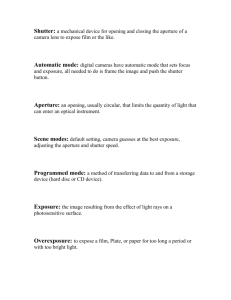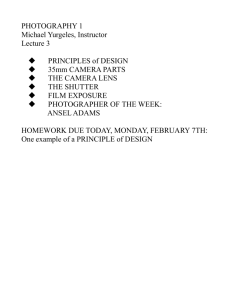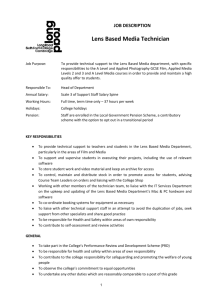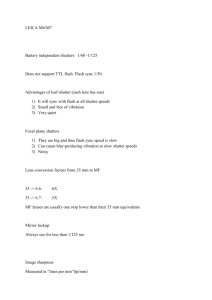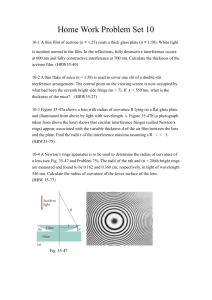Glossary of Photographic Terms and Concepts
advertisement
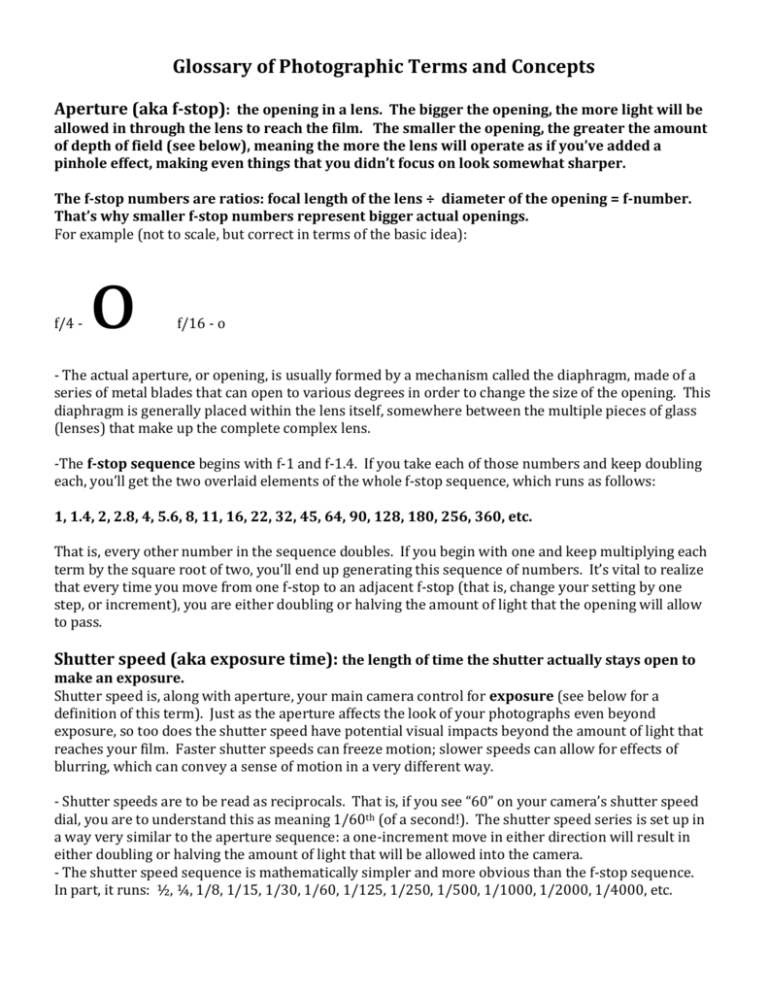
Glossary of Photographic Terms and Concepts Aperture (aka f-stop): the opening in a lens. The bigger the opening, the more light will be allowed in through the lens to reach the film. The smaller the opening, the greater the amount of depth of field (see below), meaning the more the lens will operate as if you’ve added a pinhole effect, making even things that you didn’t focus on look somewhat sharper. The f-stop numbers are ratios: focal length of the lens ÷ diameter of the opening = f-number. That’s why smaller f-stop numbers represent bigger actual openings. For example (not to scale, but correct in terms of the basic idea): f/4 - o f/16 - o - The actual aperture, or opening, is usually formed by a mechanism called the diaphragm, made of a series of metal blades that can open to various degrees in order to change the size of the opening. This diaphragm is generally placed within the lens itself, somewhere between the multiple pieces of glass (lenses) that make up the complete complex lens. -The f-stop sequence begins with f-1 and f-1.4. If you take each of those numbers and keep doubling each, you’ll get the two overlaid elements of the whole f-stop sequence, which runs as follows: 1, 1.4, 2, 2.8, 4, 5.6, 8, 11, 16, 22, 32, 45, 64, 90, 128, 180, 256, 360, etc. That is, every other number in the sequence doubles. If you begin with one and keep multiplying each term by the square root of two, you’ll end up generating this sequence of numbers. It’s vital to realize that every time you move from one f-stop to an adjacent f-stop (that is, change your setting by one step, or increment), you are either doubling or halving the amount of light that the opening will allow to pass. Shutter speed (aka exposure time): the length of time the shutter actually stays open to make an exposure. Shutter speed is, along with aperture, your main camera control for exposure (see below for a definition of this term). Just as the aperture affects the look of your photographs even beyond exposure, so too does the shutter speed have potential visual impacts beyond the amount of light that reaches your film. Faster shutter speeds can freeze motion; slower speeds can allow for effects of blurring, which can convey a sense of motion in a very different way. - Shutter speeds are to be read as reciprocals. That is, if you see “60” on your camera’s shutter speed dial, you are to understand this as meaning 1/60th (of a second!). The shutter speed series is set up in a way very similar to the aperture sequence: a one-increment move in either direction will result in either doubling or halving the amount of light that will be allowed into the camera. - The shutter speed sequence is mathematically simpler and more obvious than the f-stop sequence. In part, it runs: ½, ¼, 1/8, 1/15, 1/30, 1/60, 1/125, 1/250, 1/500, 1/1000, 1/2000, 1/4000, etc. Focal length: the optical length of the lens, which is directly related to how much the lens will magnify or reduce the size of objects viewed through the lens. A longer lens, often referred to as a telephoto lens, will magnify objects and will not include as much of the scene. A shorter lens, often referred to as a wide angle lens, will reduce the size of objects and will include more of the scene. Using lenses of different focal lengths, or zooming in or out using a zoom lens (i.e., a lens with variable focal length) will allow you to change the feeling of space as you represent a scene, so long as you also change your actual distance from the scene. (That is, you’ve actually got to move!!) Exposure: the amount of light that hits film or photo paper and the resulting density of the negative (or darkness/lightness of the print). Exposure is controlled by four factors: aperture (aka f-stop) shutter speed (aka exposure time) brightness of the scene (amount of light bouncing off of the subject matter) degree of light sensitivity of your film or photo paper (see Film Speed (aka ISO) below.) Film Speed (aka ISO): a measure of the light sensitivity of film or photo paper. The film speed scale works as follows: every doubling of the ISO number represents a doubling of the film’s light-sensitivity. This means that you will create the same density negative using ISO 800 film with camera settings of f-8 and 1/500 as you will get using ISO 400 film and camera settings of f-11 and 1/500. That is, the ISO 800 film is “one f-stop faster”: it lets you shoot with an f-stop one increment smaller and still have the same exposure you got with the larger f-stop using ISO 400 film. Lens: a piece of glass that is curved and otherwise constructed so that it gathers light (by refracting it: that means it bends light) and projects an image. Note that even though we commonly refer to the lens on a camera, most modern cameras use lenses that actually comprise (are made up of) multiple smaller lenses, or “elements.” Depth of field: a range of distances between which all objects appear acceptably sharp. The depth of field for any given shot depends upon two main factors: 1. the distance from the camera to the nearest object in view (i.e., an object that will appear in the photograph 2. the aperture (f-stop) being used for the photograph Using a smaller actual aperture (for example, f-22) will create greater depth of field. That is, objects within a greater range of distances, both behind and in front of the one you’ve focused on with the camera, will appear to be sharp. Being further away from the closest object in the scene will also create greater depth of field. For example, if the closest object within your camera’s field of view is a hundred yards away (i.e., the length of a football field), and if you focus on that object, everything behind it will also look acceptably sharp. Note that the term “selective focus” is closely related to depth of field. A photograph that includes some objects very close to the lens, and that has been taken using a very wide-open (large) aperture (e.g., f-4), will present the viewer with a strong contrast between objects that are sharply focused and others that are quite blurry. Negative: an image in which light and dark values are reversed. In general terms, photographers generally say that they shoot film in their cameras, and then process that film (running it through a set of chemical steps that includes development and fixing, with an intermediate stop bath stage and various steps relating to washing the chemicals out of the film at the end) in order to turn that film into negatives. They then print those negatives to turn them into positives. Negative: an image in which light and dark values are reversed. In general terms, photographers generally say that they shoot film in their cameras, and then process that film (running it through a set of chemical steps that includes development and fixing, with an intermediate stop bath stage and various steps relating to washing the chemicals out of the film at the end) in order to turn that film into negatives. They then print those negatives to turn them into positives. Contact Sheet: The purpose of a contact print is to let you see all the images from a set of negatives in positive form, and at the same size as your negatives. Photographers look at their contact sheets to evaluate their compositions and to decide which negatives to enlarge. When making a contact print, you place your negatives in direct contact with the photo paper. Test strip: The purpose of a test strip is to make multiple guesses about what exposure time (using a certain f/stop) might be best for your print. Test strips should be made for any new print you are making, whether that’s going to be a contact print or an enlargement. Test strip for a contact print (from the web! – very dusty!): Test strip for an enlargement (also from the web):
